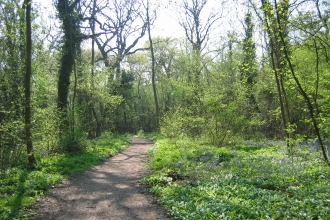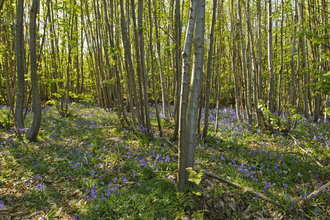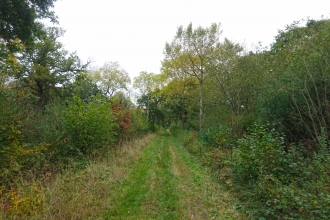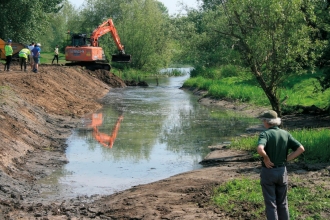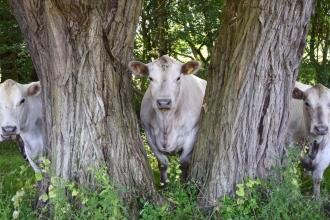Woodlands have been essential to people for thousands of years. They are used for timber, fuel and shelter, and more recently for public recreation as well. We know woodlands play an important functional role in securing carbon, purifying the air we breathe and also helping prevent flooding.
Historically much of the woodland in Britain and across Beds, Cambs and Northants has been lost. That which remains may have suffered through both lack of management or wholesale removal of trees. In addition, the planting of and or colonisation of non-native trees may have reduced the native wildlife that woodlands can support.
Our area is now among the least wooded in the UK, which as a country is one of the least wooded in Europe. This makes our remaining ancient woodlands precious and important within the landscape.
We're committed to maintaining and enhancing the woodlands under our management, and where appropriate restoring those woodlands, which may have suffered in the past, to be more in keeping with native British broad-leaved woodland.
Frequently Asked Questions
Read on for answers to your questions about how we manage our woodlands.
Why are trees being cut down?
All woodlands in the UK have been managed through felling trees at some stage in their life. Indeed, the reasons people and wildlife may benefit from a particular woodland could be due to the way it has been managed in its past. For example, large veteran oaks provide much visual and wildlife value, but would not exist without the felling of trees around them over their lifetime.
One of the main aims of our woodland management is to create woodland that is made up of trees of varying heights, ages and species. By doing this we are creating a wide range of places (habitats) where different plants and animals can co-exist.
Woodlands made up of similar sized and aged trees with little variation in tree species can only support a limited number of plant and animal species. By actively managing woodlands through tree felling we are able to create light and shade, wetter and drier areas and ensure varied structure to the woodland, which will support a much greater range of woodland species. We are also protecting woodlands for the future by allowing space for the next generation of trees to replace those that exist now, and by making them resistant to diseases and pests that target individual tree species.
Why can’t woodlands be left alone to be "natural"?
Much of the woodland wildlife that is now endangered used to rely on key natural processes to survive. These could include individual trees dying or whole area of woodland blowing over to create open space for wildflowers and shrubs, large herbivores keeping areas open through grazing, beavers raising local water levels and and dead and decaying wood providing habitat for insects. More natural woodland is a dynamic mixture of conditions in which a wide range of wildlife thrived.
The woodlands that remain in the UK are only fragments of huge sprawling woodlands of the past that merged and complemented other habitats. Many of the important species such as large herbivores and carnivores that once help to drive natural woodland processes have been lost. This means that the regular creation of conditions that endangered species rely on now occur less frequently in individual woodlands. This has contributed to a significant decline in woodland wildlife.
Our remaining woodlands now are embedded in a very different landscape to the past, often completely surrounded by intensively managed farmland that is hostile to many woodland species and brings impacts such as indirect pollution from fertilizers and herbicides. This modern landscape also prevents the migration of smaller animal and plant species, making their remaining woodland populations vulnerable to being lost.
Our work aims to recreate the right range of conditions to prevent the further loss of wildlife. We do this through a variety of traditional techniques including felling trees, creating and cutting open areas, encouraging dead wood, and allowing new trees to establish. Where the full range of natural processes cannot operate science has shown that well managed woodlands can hold a greater diversity of wildlife than unmanaged woodlands.
How does using machinery to fell trees impact the woodland?
Traditionally, woodlands were managed using low impact techniques such as felling by hand and moving wood with horses. This way of working is now no longer economical or sustainable and so where appropriate, machinery may be used to provide the required woodland management. Whilst the use of machinery can cause disturbance, not managing our woodlands to provide the right conditions would be more damaging to the wildlife that lives there. We also take many precautions to minimise the disturbance caused by machinery.
Before any work commences, areas are checked for sensitive wildlife, and workers are made aware of places to avoid. Tree felling takes place outside of the the most disturbing times for most wildlife such as bird nesting season and potential bat roosts are marked and left alone. Dedicated routes for moving machinery are also used to minimise disturbance to the soil, and any deep rutting is repaired.
Why does it look so different after management?
Whilst the management of woodlands can cause a significant visual change in the short term, we must remember the importance of undertaking the management to ensure are woods are healthy for the long term. An area that has been managed may not return to how it looked for several decades as woodlands are slow growing and change over far longer periods. Whilst as humans we see the change and expect it to return to how it was quickly, woodlands work in centuries and therefore the work that we undertake now will be for the benefit of wildlife and people for generations to come.
Why do paths or woodlands have to be closed?
Some paths may have to be closed temporarily as the work cannot be done safely without the exclusion of people. Workers operating machines may have limited visibility and trees being processed have the potential to fall on unaware pedestrians (or their dogs). There may also be issues relating to the extraction of timber by machinery and lorries and large timber stacks that pose a significant risk to to visitors.
There are also times when woodland soils can be easily impacted and plants such as bluebells destroyed through people wandering from paths or widening paths in wet weather. Whilst we aim to keep woodlands open we may need to temporarily close paths or even entire woodlands to protect their precious wildlife.
We apologise for any inconvenience when restricting access and if possible try to make sure there are alternative routes are available or suggest other places to visit locally.
How is it decided which trees are cut down?
Our woodland management is carried out based on maintaining and enhancing the feeding, living and breeding needs of many different species by ensuring the habitat is diverse in age and structure, ranging from young and open to old and mature with a closed canopy. Trees may be cut down regularly on a cycle to create semi-permanent open, sunny and dense shrubby areas, ideal for insects and nesting birds. The cutting down of only a selection of trees, known as thinning, is to give the remaining trees space to grow and mature and allow young trees and shrubs to establish beneath them, producing a layered structure. In the majority of our woodlands most trees are left to become large and mature and the areas have a closed, shady canopy with increasing levels of dead and dying trees.
Our management of woodland is based on published research and guidance as well as being informed by experienced staff and volunteers who collaborate to plan, complete and record actions in woodland management plans. There are often additional shorter-term work plans created in collaboration with the Forestry Commission and Natural England to help meet national targets for well managed woodland and ensure nationally important woods are in good ecological condition.
To fell more than a very small number of trees an approved license is needed from the Forestry Commission, the statutory body responsible for authorising and regulating this kind of work. The license defines the area of trees, types of trees and the volume of the trees as well as ensuring a return to tree cover. Where our woods are also nationally important (Sites of Special Scientific Interest) formal consent from the ecological regulator Natural England is needed. These permissions cover the different types of management to be carried out throughout the woodland to protect and benefit the habitats and species of interest and follows the UK Forestry Standard.
How is ash dieback being dealt with?
Ash dieback is a disease that has been sweeping its way across the country killing off a majority of ash trees where it hits. The disease is spread by fungal spores and results in branches dying back and falling off and the eventual death of the tree in almost all cases. We recognise the damage to people, property and wildlife that this disease has the potential to cause and follow expert advice to take proactive steps that mitigate the effects.
Over time, ash trees infected with the disease become unpredictable, making them more dangerous and expensive to deal with the longer that they are left. Where ash trees in infected woodlands pose a threat to people and property, particularly on the sides of busy roads, we will remove the ash trees within road striking distance. We will judge each of our nature reserves on a case by case basis and the likelihood of the trees causing injury or damage.
Where infected woodlands contain a high density of ash trees, we may also remove a proportion of ash in favour of other species. We will retain saplings and larger trees that show fewer symptoms as it is thought that some ash will be genetically resistant to ash dieback. This management aims to give a head start to the woodland recovery following the initial impact, with alternative species and resistant ash trees ready to replace the ash that is lost.
How does woodland management impact climate change?
To provide any form of useful carbon storage, woodlands need to exist and be protected in the long term, not just in the present. We recognise this, and sustainable management that protects and enhances our woodlands is the basis of our long term vision in our woodland strategy.
What this means is that the rate at which carbon is removed through tree felling is less than the rate at which it is stored in the trees, soils and other organic matter throughout the woodland. Only a very small proportion of our woodlands are managed in any one year and at least half of the area of any individual woodland will remain unmanaged. Any timber products coming out of the wood are potentially reducing or replacing the need for activities that use fossil fuels and decreasing the need to import timber from abroad such as tropical rainforests. Management can increase carbon storage in a woodland by reducing competition for large trees (allowing them to grow even larger), and by increasing organic activity in the soil and the establishment of new trees. Furthermore, the tree felling work that adds resilience and wildlife benefit to our woodlands does not result in deforestation. This way the woodlands will not only contribute to tackling climate change now, but they will be around to do so over centuries to come.
Where is the timber going?
In order to sustainably manage our woodlands for people and wildlife in the long term, it is necessary to cover the costs of management. Timber and firewood generated from management is sold and money is reinvested in our woodland nature reserves. As a charity, we do not make a profit from selling timber or biomass. The money that is brought in pays for the tree felling itself as well as a range of activities such as improving access and signs, tree planting, tools and equipment, as well as other habitat management work that comes at a cost.
A proportion of the wood is also left as standing and fallen dead wood which provides habitat to a range of wildlife, including birds, fungi, bats and insects. The dead wood further decays over a longer time period to provide the soils of the future.
Where possible we also look to process on site felled hardwood timber such as oak , ash or elm to produce a range of gateposts, fencing, planks and seats on our reserves, reducing the need to purchase or import these products.
Ash dieback
Ash Dieback disease affects our native ash tree, initially causing trees to lose vigour through leaves withering and dying, progressing to death of twigs, branches and trunk. In most instances, eventually the whole tree will die.
This disease is spreading through our three counties and it has the potential to profoundly change our familiar rural and urban landscapes and particularly our boulder clay woodlands with the loss of mature stately grey skinned ash trees.
Find out how we are managing ash dieback and how you can support us

